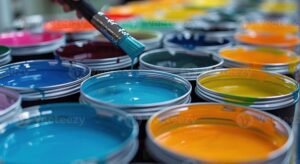Introduction to Pigmentation in Wall Paints
Pigmentation in wall paints is a fundamental aspect that dictates the color, texture, and overall appearance of the surface. Essentially, pigments are finely ground particles that impart color to paint formulations, making them vital for achieving the desired hue and shade. The types of pigments utilized can vary widely, encompassing both organic and inorganic materials, each contributing distinct qualities to the paint. For instance, inorganic pigments typically offer excellent opacity and durability, while organic pigments can provide vibrant colors but may be less stable over time.
The significance of pigmentation extends beyond mere aesthetics. It plays a crucial role in the durability and performance of wall paints. High-quality pigments can enhance the weather resistance of exterior paints, ensuring that they maintain their color and finish when exposed to various environmental factors, such as UV radiation and moisture. Similarly, the choice of pigment affects the hide and coverage of the paint, determining how well it conceals underlying surfaces.
Furthermore, pigmentation is a key component in achieving the aesthetic objectives in interior designs. The right selection and combination of pigments can greatly impact the mood and ambiance of a space. Light-reflective pigments can make a room feel more spacious and airy, while darker pigments can provide a sense of intimacy and warmth. The interplay of these pigments is essential for interior decorators and designers as they seek to create cohesive and inviting environments.
Understanding the role of pigmentation in wall paints is vital for both consumers and professionals in the painting industry. Knowledge about the types of pigments available and their properties can help in making informed decisions, ultimately enhancing both the visual appeal and longevity of painted surfaces.
Types of Pigments Used in Wall Paints
Understanding the types of pigments used in wall paints is crucial for selecting the right product for your painting project. Pigments can generally be categorized into two main groups: organic pigments and inorganic pigments. Each category has distinct characteristics that influence the paint’s performance, durability, and colorfastness.
Organic pigments are carbon-based compounds that tend to offer vibrant colors and transparency. They are often favored for their ability to produce bright shades, making them ideal for decorative and artistic applications. However, while organic pigments do exhibit excellent aesthetic qualities, they may have limitations in terms of lightfastness and durability, especially when exposed to outdoor conditions. This makes them less suitable for exterior paint products unless formulated with protective additives.
On the other hand, inorganic pigments are derived from mineral sources and typically exhibit better stability and opacity. These pigments are known for their durability and resistance to fading, which makes them particularly effective for exterior wall paints. Inorganic pigments, such as iron oxides, provide strong coverage and are less susceptible to UV damage. However, their color palette is often more muted as compared to organic alternatives, which may limit choices for certain design aesthetics.
When considering the overall performance of wall paints, it is essential to acknowledge that the choice of pigment impacts not only the visual appeal but also the longevity of the paint. A blend of organic and inorganic pigments can be utilized to enhance both color vibrancy and durability. Understanding these different types of pigments will allow for informed choices in selecting paints that meet specific requirements, enhancing the overall appearance and performance of the painted surfaces.
The Science Behind Color Mixing in Pigmentation
Color mixing is an essential concept in the realm of wall paints, governed by the principles of color theory. At the core of this theory are the primary colors—red, blue, and yellow. These colors are fundamental because they cannot be created by mixing other colors. By combining these primary colors in various proportions, secondary colors emerge. For instance, mixing red and blue produces purple, blue and yellow yield green, while red and yellow create orange.
The color wheel, a crucial tool in understanding relationships between colors, displays the arrangement of hues in a circular format. It illustrates how primary colors can be blended to form secondary colors and further mixed to produce tertiary colors, such as yellow-orange or blue-green. This systematic approach to visualizing color relationships aids in selecting harmonious palettes for wall paints, ensuring aesthetic appeal and coherence in design.
The process of mixing pigments to achieve desired shades involves two main methods: additive and subtractive color mixing. Additive mixing occurs with light, where colors combine to create a new hue. In contrast, subtractive mixing involves pigments, where combining pigments absorbs certain wavelengths of light and reflects others, resulting in the visible color. This fundamental difference highlights why the mixing of paints often yields a darker hue compared to that of added light.
Additionally, the quality and type of pigments used can profoundly influence the outcome. Organic and inorganic pigments, for example, exhibit different properties, such as opacity and brightness, affecting the final appearance of the paint on walls. Understanding these characteristics allows consumers and professionals alike to select the most appropriate pigments to achieve their desired color outcomes efficiently.

Factors Affecting Pigmentation in Wall Paints
The pigmentation in wall paints is influenced by a variety of factors that contribute to the final appearance and durability of the finish. One primary consideration is the type of surface being painted. Different materials, such as drywall, wood, or metal, absorb and reflect paint differently due to their inherent properties. For instance, a porous surface may require a primer to seal it effectively before applying color coats, which impacts the overall pigmentation. Furthermore, the texture of the surface plays a role; a rough surface can create an uneven spread of pigment, leading to variations in color depth.
Another significant factor is the lighting conditions under which the paint is applied and subsequently viewed. Natural light, artificial light, and the direction of this light can significantly alter the perception of color. For example, a paint that appears vibrant under bright daylight may look subdued or muted under artificial lighting. This dynamic interplay between light and color highlights the importance of testing paint samples in the actual environment where they will be applied to gauge their appearance accurately.
Environmental factors also have a profound impact on pigmentation endurance and performance. Factors such as humidity and temperature can affect how paint adheres to surfaces and how pigments interact once dried. Suboptimal conditions, like high humidity or extreme temperatures, can lead to issues such as fading or peeling, ultimately affecting the paint’s longevity and aesthetic appeal. Additionally, proper preparation and application techniques are crucial. These include adequately cleaning and priming surfaces, selecting suitable tools for application, and applying multiple thin coats instead of a single heavy coat to ensure even pigmentation. Recognizing and managing these factors effectively leads to enhanced results in wall paint applications.
The Role of Pigmentation in Paint Performance
Pigmentation plays a crucial role in determining the overall performance of wall paints, influencing various characteristics such as coverage, opacity, durability, and resistance to environmental factors. The type and quality of pigments used in paint formulations directly impact how effectively a paint can conceal the underlying surface. High-quality inorganic pigments, for example, provide excellent opacity, meaning less paint is required to achieve a uniform finish, resulting in cost-effectiveness and reduced number of layers needed for application.
Moreover, the durability of paint is significantly affected by its pigmentation. Certain pigments enhance the resistance of paint films to environmental stresses, including ultraviolet (UV) light, moisture, and mildew. Paints that incorporate specialized pigments designed to reflect UV rays not only protect the integrity of the color but also prolong the lifespan of the paint film. This is particularly important in areas that experience harsh weather conditions, as prolonged exposure to sunlight can lead to color fading and degradation of the paint’s surface.
In addition to durability, the choice of pigments can enhance the paint’s resistance to moisture and mildew growth. For instance, antifungal agents combined with specific pigments contribute to the formation of mildew-resistant films. This characteristic makes certain paints ideal for use in humid climates or areas prone to moisture, such as bathrooms and kitchens. Furthermore, pigments also influence the texture of the paint, contributing to the overall aesthetic appeal and tactile experience when applied to walls.
Ultimately, the interplay between pigmentation and performance characteristics establishes a foundation for choosing the appropriate paint for specific applications. Different formulations offer varying levels of performance, guiding consumers and professionals alike in making informed choices to ensure the longevity and effectiveness of the paint on their walls.

Eco-Friendly Pigmentation Options
With an increasing awareness of environmental issues, the demand for sustainable and eco-friendly pigment options in wall paints has gained significant momentum. Traditional synthetic pigments, while effective in providing vibrant colors, often contain harmful chemicals that pose risks to both human health and the environment. These synthetic pigments can release volatile organic compounds (VOCs) into the air, contributing to air pollution and respiratory problems. Consequently, the paint industry has witnessed a shift towards more sustainable practices, focusing on natural pigments derived from organic sources.
Natural pigments, which are derived from minerals, plants, and other organic materials, offer a more environmentally friendly alternative. Examples include pigments extracted from clay, charcoal, and fruit dyes, which not only provide an ecologically sound choice but also a unique aesthetic appeal. Natural pigments tend to be safer for both indoor and outdoor applications, as they generally contain lower levels of harmful substances. This eco-conscious approach ensures that when applied, these paints contribute to a healthier living environment, making them a preferred choice for environmentally minded consumers.
The rise of green chemistry has further propelled the search for innovative, biodegradable pigment options in the paint industry. Researchers are developing new formulations that minimize or eliminate toxic substances and enhance sustainability. These advancements include low-VOC and zero-VOC paints, which significantly reduce harmful emissions while maintaining color quality and performance. Prominent brands are now adopting these environmentally friendly formulations, which not only cater to consumer demand for eco-conscious choices but also contribute positively to the overall health of the planet.
In conclusion, the increasing availability of eco-friendly pigment options marks a significant shift in the paint industry. By prioritizing natural and sustainable materials, consumers can make informed decisions that benefit both their health and the environment.

Choosing the Right Pigmentation for Your Painting Project
Selecting the appropriate pigmentation for a painting project plays a pivotal role in achieving the desired aesthetic and functional outcomes. To begin, it is essential to consider your color preferences. Color selection should reflect the style you wish to create, whether it is a serene atmosphere with soft hues or a vibrant energy with bold shades. Utilizing color swatches in natural light can aid in visualizing how different pigments will interact with your space.
Equally important is the intended use of the space. For example, high-traffic areas may benefit from durable, washable paint that retains its vibrancy over time. In contrast, more intimate spaces like bedrooms may call for softer tones that foster relaxation and comfort. Different types of pigments, such as organic versus inorganic options, can have varying effects on durability and finish, thereby impacting the suitability of a color in specific environments.
The psychological effects of colors are also a significant consideration in the selection process. Research suggests that certain pigments can influence mood and perception. For instance, blues and greens tend to evoke calmness, while yellows and oranges can create feelings of warmth and cheer. By understanding the emotional impact of various colors, you can choose pigments that align with the purpose of the room and the ambiance you wish to cultivate.
In addition, consider the compatibility of the pigments with your existing decors, furniture, and lighting. The interplay between colors in a room can vastly change its overall appearance. Utilizing a color wheel may help in identifying complementary shades that can create a cohesive look. Ultimately, taking the time to thoughtfully evaluate these factors will lead to a more satisfying and visually appealing painting project.

Common Misconceptions about Paint Pigmentation
Understanding paint pigmentation often comes with a range of misconceptions that can mislead consumers when selecting wall paints. One prevalent myth is that all paints will fade equally over time. In reality, the rate of color fading varies considerably depending on the type of pigment used, the paint’s binders, and environmental factors such as sunlight exposure. Higher quality paints typically incorporate UV-resistant pigments, which can help maintain color vibrancy longer than their less expensive counterparts.
Another common misunderstanding involves the differentiation between types of paints. Many consumers assume that all paints labeled for similar uses are essentially the same. However, acrylic paints generally offer better durability and pigment retention when compared to traditional oil-based paints. This difference impacts both application and long-term performance, meaning that selection should be informed by intended use rather than price alone.
It is also a frequent misconception that a higher price always equates to superior paint quality. While it is true that higher-cost paints often utilize better quality pigments and advanced binding agents, the price does not always guarantee performance. Factors such as the specific shade of paint, the finish (matte, satin, or gloss), and even brand reputation can all influence cost. Therefore, consumers should evaluate pigment quality not just by price but also by manufacturer specifications and customer reviews.
By debunking these common myths, one can approach paint selection with a clearer understanding of paint pigmentation characteristics. Understanding these key elements helps consumers make informed decisions, ensuring they select the right type of wall paint that meets their aesthetic and functional needs. Addressing misconceptions promotes a more educated choice, enhancing satisfaction with the chosen product.
Conclusion and Final Thoughts
Understanding pigmentation in wall paints is crucial for anyone looking to engage in painting projects, whether for residential or commercial spaces. Throughout this guide, we explored the various aspects of pigmentation, including the types of pigments used, their impact on color variations, and how they influence overall paint quality. We highlighted the role of pigments in determining the opacity, durability, and finish of paints, emphasizing that these factors can significantly affect the visual appeal and longevity of any painted surface.
Moreover, we discussed the importance of selecting the right pigments based on the desired outcome and environment. For instance, natural pigments are often favored for eco-friendly projects, while synthetic options may provide more vivid and long-lasting colors. Each choice comes with its own set of advantages and potential drawbacks, making it essential for homeowners and commercial decorators to make informed decisions based on the specific requirements of their projects.
As we conclude this comprehensive guide on the pigmentation in wall paints, it is evident that knowledge about pigment types and their properties can lead to better choices in paint applications. By considering factors such as color perception, application methods, and environmental impact, individuals can maximize their satisfaction with the paint results. We encourage readers to delve deeper into the topic and reflect on how the information presented can influence their future painting endeavors. Making informed decisions about pigmentation will undoubtedly enhance not only the aesthetics but also the functionality of painted surfaces, ensuring long-lasting and satisfying results.

